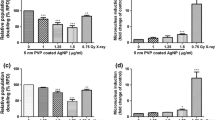Abstract
Nano-silver (Ag) with antimicrobial activity is by far the most commercialized nano-compound. The hazards associated with human exposure to nanosized-silver should be investigated to facilitate the risk assessment process. Recent studies have shown that inflammatory, oxidative, genotoxic, and cytotoxic consequences are associated with silver particulate exposure, and are inherently linked. In the present study, the cytotoxicity and genotoxicity of nano-silver were investigated using the dye exclusion assay, the comet assay, and the mouse lymphoma thymidine kinase (tk+/−) gene mutation assay (MLA). IC20 values of nano-silver in L5178Y cells were determined the concentration of 3,769.53 μg/mL and 1,796.88 μg/mL with and without S-9, respectively. And in BEAS-2B cell, IC20 values were calculated to 1,171.88 μg/mL and 761.72 μg/mL with and without S-9, respectively. From these results, nano-silver was more cytotoxic in absence of S-9 metabolic activation system and at the BEAS-2B cells. In the comet assay, L5178Y cells and BEAS-2B cells were treated with nano-silver which significantly increased >2-fold tail moment with and without S-9. However, the mutant frequencies in the nano-silver treated L5178Y cells were slightly increased but not significant compared to the vehicle controls with and without S-9. The results of this study indicate that nano-silver can cause primary DNA damage and cytotoxicity but not mutagenicity in cultured mammalian cells.
Similar content being viewed by others
References
Dey, S. et al. Interactions between SIRT1 and AP-1 reveal a mechanistic insight into the growth promoting properties of alumina (Al2O3) nanoparticles in mouse skin epithelial cells. Carcinogenesis 29:1920–1929 (2008).
Balasubramanyam, A. et al. In vivo genotoxicity assessment of aluminium oxide nanomaterials in rat peripheral blood cells using the comet assay and micronucleus test. Mutagenesis 24:245–251 (2009).
Colvin, V. L. The potential environmental impact of engineered nanomaterials. Nat Biotechnol 21:1166–1170 (2003).
Wijnhoven, S. W. P. et al. Nano-silver-a review of available data and knowledge gaps in human and environmental risk assessment. Nanotoxicology 3:109–138 (2009).
Ip, M. et al. Antimicrobial activities of silver dressings: an in vitro comparison. J Med Microbiol 55:59–63 (2006).
Melaiye, A. et al. Silver (I)-imidazole cyclophane gemdiol complexes encapsulated by electrospun tecophilic nanoWbers: formation of nanosilver particles and antimicrobial activity. J Am Chem Soc 127:2285–2291 (2005).
Lubick, N. Nanosilver toxicity: ions, nanoparticles-or both? Environ Sci Technol 42:8617 (2008).
Arora, S., Jain, J., Rajwade, J. M., Paknikar, K. M. Cellular responses induced by silver nanoparticles: In vitro studies. Toxicol Lett 179:93–100 (2008).
Foldbjerg, R. PVP-coated silver nanoparticles and silver ions induce reactive oxygen species, apoptosis and necrosis in THP-1 monocytes. Toxicol Lett 190:156–162 (2009).
AshaRani, P. V., Mun, G. L. K., Hande, M. P. & Valiyaveettil, S. Cytotoxicity and genotoxicity of siver nanoparticles in human cells. ACS Nano 3:279–290 (2009).
Singh, N. P. et al. A simple technique for quantitation of low levels of DNA damage in individual cells. Exp Cell Res 175:184–191 (1988).
Tice, R. R. et al. The single cell gel/comet assay: guidelines for in vitro and in vivo genetic toxicology testing. Environ Mol Mutagen 35:206–221 (2000).
Anderson, D. & Plewa, M. J. The international comet assay workshop. Mutagenesis 13:67–73 (1998).
Fairbairn, D. W., Walburger, D. K., Fairbairn, J. J. & O’Neill, K. L. Key morphologic changes and DNA strand breaks in human lymphoid cells: discriminating apoptosis from necrosis. Scanning 18:407–416 (1996).
Speit, G. & Hartmann, A. The comet assay (single-cell gel test). A sensitive genotoxicity test for the detection of DNA damage and repair. Methods Mol Biol 113:203–212 (1999).
Lok, C. N. et al. Proteomic analysis of the mode of antibacterial action of silver nanoparticles. J Proteome Res 5:916–924 (2006).
ATSDR (Agency for toxic substances and Disease Registry) Toxicological profile for Silver. Prepared by Clement international corporation, under Contract 205-88-0608). U.S. public Health Service. ATSDR/TP-90-24 (1990).
Hussain, S. M. et al. In vitro toxicity of nanoparticles in BRL 3A rat liver cells. Toxicol In Vitro 19:975–983 (2005).
Hussain, S. M. et al. The interaction of manganese nanoparticles with PC-12 cells induces dopamine depletion. Toxicol Sci 92:456–463 (2006).
Braydich-Stolle, L., Hussain, S., Schlager, J. J. & Hofmann, M. C. In vitro cytotoxicity of nanoparticles in mammalian germline stem cells. Toxicol Sci 88:412–419 (2005).
Carlson, C. et al. Unique cellular interaction of silver nanoparticles: size-dependent generation of reactive oxygen species. J Phys Chem B 112:13608–13619 (2008).
Arora, S., Jain, J., Rajwade, J. M. & Paknikar, K. M. Cellular responses induced by silver nanoparticles: in vitro studies. Toxicol Lett 179:93–100 (2008).
Foldbjerg, R., Dang, D. A. & Autrup, H. Cytotoxicity and genotoxicity of silver nanoparticles in the human lung cancer cell line, A549. Arch Toxicol Epub ahead of print (2010).
Kumari, M., Mukherjee, A. & Chandrasekaran, N. Genotoxicity of silver nanoparticles in Allium cepa. Sci Total Environ. 407:5243–5246 (2009).
Kuriyama, R. & Sakai, H. Role of tubulin-SH group in polymerization to microtubules. J Biochem 76:651–654 (1974).
Klasterska, I., Natarajan, A. T. & Ramel, C. An interpretation of the origin of subchromatid aberrations and chromosome stickiness as a category of chromatid aberrations. Hereditas 83:153–162 (1976).
Lesniak, W. et al. Silver/Dendrimer nanocomposites as biomarkers: fabrication, characterization in vitro toxicity, and intracellular detection. Nano Lett 5:2123–2130 (2005).
Hsin, Y. H. et al. The apoptotic effect of nanosilver is mediated by a ROS- and JNK-dependent mechanism involving the mitochondrial pathway in NIH3T3 cells. Toxicol Lett 179:130–139 (2008).
Sung, J. H. et al. Lung function changes in spraguedawley rats after prolonged inhalation exposure to silver nanoparticles. Inhal Toxicol 20:567–574 (2008).
Clements, J. Gene mutation assay in mammalian cells, In O’Hare, S. & Atterwill, C. K. (Ed.), Methods in Molecular Biology, Vol. 43, In vitro Toxicity Testing Protocols. Humana Press Inc. Totowa, NJ. 43:277–286 (1990).
Robinson, W. D. et al. Statistical evaluation of bacterial/mammalian fluctuation test, in Statistical Evaluation of Mutagenicity Test Data (Kirkland, D. J., ed.). Cambridge University Press. Cambridge, UK, 102–140 (1990).
Author information
Authors and Affiliations
Corresponding author
Rights and permissions
About this article
Cite this article
Kim, YJ., Yang, S.I. & Ryu, JC. Cytotoxicity and genotoxicity of nano-silver in mammalian cell lines. Mol. Cell. Toxicol. 6, 119–125 (2010). https://doi.org/10.1007/s13273-010-0018-1
Received:
Accepted:
Published:
Issue Date:
DOI: https://doi.org/10.1007/s13273-010-0018-1




